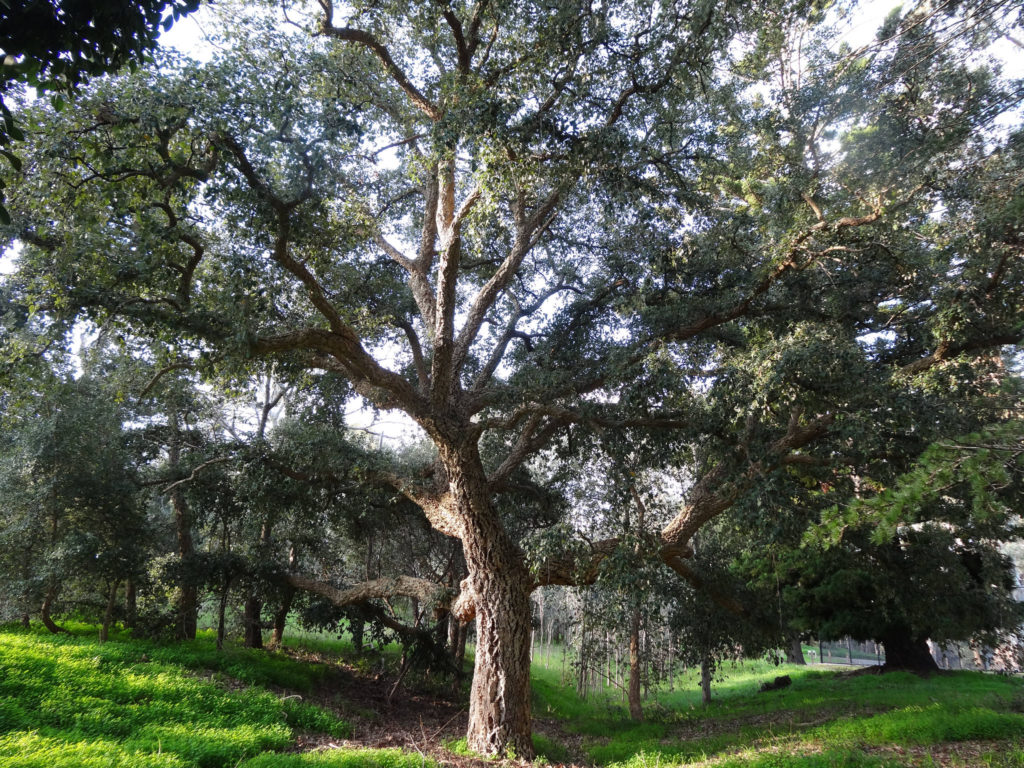- About Us
- Our Work
- Tree Info
- Get Involved
- Blog
- Volunteer
- Support Us
By Canopy Team on October 22, 2018

Photo by Denisbin via Flickr.
Tree Spotlight Series: Follow along as we learn about the fascinating trees that live among us. This series is in partnership with Rhee Lab in the Plant Biology Department of the Carnegie Institution for Science.
Other posts in the series: ginkgo biloba, Douglas fir, giant sequoia, Chinese tallow, silver-dollar gum, Monterey pine, green dracaena, and coast live oak.

Imagine having a fancy dinner with family, friends, or a loved one. You pop open a bottle of wine and untwist the cork from the wine opener—the cork is light and rubbery in your hand. If the occasion is special enough, you may save the cork as a memento of the evening. The cork stopper is unassuming and easily forgotten, thrown out or piling up in a box in our homes, but it is a vital part of the wine industry. All the cork used to make these stoppers is harvested from one species of tree—the cork oak.
The cork oak (Quercus suber) is a large evergreen oak tree native to Spain, Portugal, and the Mediterranean region. It has green spiny leaves, twisted branches, and deeply fissured bark. But beneath the top layer of bark is a thick spongy layer of cork.
At the start of the seedling’s life, the cork oak mainly grows upwards, a process known as primary growth. Later on, the oak grows in thickness to support itself—this is called secondary growth. Cells become dense with a sturdy molecule called lignin and the brown wooden bark is made. Just underneath the bark, there is a ring of specialized cells around the trunk called the cork cambium. The cork cambium creates special cork cells and pushes them outwards.
Mature cork cells are actually dead and heavily packed with a large molecule called suberin. Suberin is a very stable molecule that resists both water and fire. This layer of cork forms a seal around the tree, protecting it from the outside world.
Cork from cork oak trees is constantly being produced and can be harvested every few years. Since the tree produces such a thick layer of it, and since the cork cells themselves are not living, harvesting cork does not actually harm the tree. This makes cork a truly reliable resource. As a material, cork is invaluable to the wine, flooring, and textile industries.
Additionally, wild cork oak groves are protected ecosystems. Cork oaks provide homes for a variety of endangered organisms including the Barbary ape and the Iberian lynx, the most critically endangered feline in the world. In fact, in Portugal, cork is such a valuable source of income and biodiversity that it is illegal to cut down any cork oak.
A recent shift away from using cork stoppers in wine bottles may pose a threat to the cork oak. If the economic value of the tree diminishes, they might be less protected, and that may threaten the ecosystems they uphold. But while wine corks are seeing a decrease, cork is still being used to make many other things, such as flooring, bags, shoes, jewelry. Our fascination with this incredible material is far from over, and cork oaks around the world continue to thrive.

Galyna Vakulenko was a 2018 summer intern at the Rhee Lab in the Plant Biology Department of the Carnegie Institution for Science at Stanford University. She is an undergraduate student majoring in plant physiology at Carleton University in Ottawa, Canada.